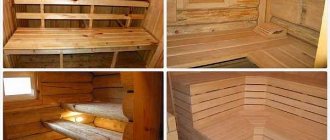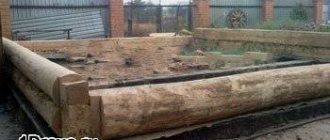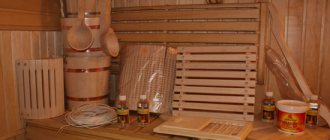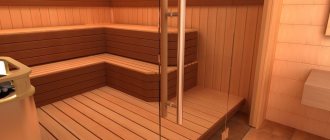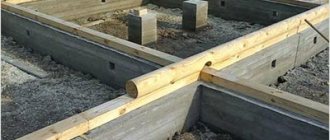Today, many people order log baths - such buildings are durable and, with proper maintenance, will last for more than a century. To prevent the walls from sagging, you need to monitor the condition of the foundation and lower crowns, and if necessary, replace damaged elements or carry out repair work. To make such a restoration, you need to jack up the frame, after which you will have access to the lower part of the wall.
Such work can be carried out by specialists; you will need to pay for materials and the cost of services. If you want to do the finishing yourself, study the technology that we will discuss below.
Preparatory work
At the preparatory stage, before moving the building vertically, the necessary measures should be taken to prepare the structure in order to prevent emergency situations and possible destruction:
- turn off the electrical power supply;
- turn off the water supply lines;
- disconnect the sewer pipes;
- ensure a guaranteed gap between the stove chimney and the ceiling;
- disconnect the heating device installed on a separate basis from the pipes;
- dismantle the floor in the area adjacent to the stove or heating boiler;
- attach metal profiles to the corners of the building to secure the box;
- dismantle window sashes to preserve the integrity of the glass.
Before work begins, a lifting scheme is worked out, which is determined by the purpose of the operation and the type of damage to the structure.
It is also necessary to carry out the following work:
- Assess the level of damage and perform a visual inspection of the foundation. To do this, it is necessary to dismantle the basement cladding, provide access to the base along the contour of the building, and locally go deeper into the soil.
- Check the strength and condition of the support rim. The solid wood should be tapped with a hammer to identify problem areas prone to rotting and cracking.
- Ensure delivery of all necessary materials and equipment to the work site. Timely preparation of jacks, materials for repairs, and temporary supports will reduce the duration of repair activities.
It is important to correctly determine the method of lifting the structure and first analyze a number of points:
- Bath weight. The weight of the box, ceiling elements, external and internal decoration, as well as equipment located in the room is taken into account. By multiplying the resulting value by a factor of 1.4 and dividing by the number of jacks, you can obtain the load capacity of each device.
- Dimensions of a wooden box. By installing additional supports in the areas where logs, beams or wooden frames join, you can significantly reduce the likelihood of box deformation in the area where the elements join.
- Strength and presence of cladding on the inside and outside of the room. The presence of decorative finishing complicates the work. Fixing diagonally spaced bars 5 cm thick will protect the bathhouse frame from deformation and avoid subsequent repairs.
The lifting operation must be carried out taking into account further work
- The nature of the soil. The possibility of immersing lifting devices when moving a building in the vertical direction depends on the characteristics of the soil. Increasing the support area with the help of pads will ensure the immobility of the jacks.
- Lifting height. The design features of the lifting device limit the amount of free play of the rod. The required moving height is achieved by using supports made of durable wood.
- Duration of repair work. Depending on the level of complexity of the repair, the duration of restoration activities is determined. The use of temporary structures made of steel and durable wood reduces the load on the rod.
A responsible approach to repair work will allow you to avoid unforeseen situations, as well as promptly complete planned repairs.
Rules for lifting a structure
What to do when it’s time to overhaul a bathhouse with distortions and sagging corners? In this case, the bath structure rises above the surface completely or partially. The video shows clearly and in detail how we raise the bathhouse.
The most optimal option for carrying out such an event is the use of high-power jacks. The lift allows access to the foundation and lower crowns of the frame. The lifting procedure is quite complex and requires special care, because... incorrect actions can lead to destruction of the ligaments and the material itself.
Advice! Before lifting the bathhouse on jacks, it is necessary to assess the load on the mechanisms, which will allow you to correctly select the power of the device.
Jacks are installed, as a rule, in the corners of the structure, and 1 device accounts for ¼ of the entire mass of the structure. Most often, mechanisms with a capacity of at least 4.5-5 tons are used.
Before work begins, a lifting scheme is worked out, which is determined by the purpose of the operation and the type of damage to the structure. Typically, at least 2 jacks are used for work. The exception is cases when only 1 corner of the bathhouse sank. To eliminate deformation, only the sagging corner is raised to the required height. For all other work, jacks are used in pairs, lifting the entire wall, which will preserve the integrity of the corner alignment of the logs.
The operation itself should be carried out smoothly, gradually. Precautions must be observed. When the structure is fully raised, work is carried out in cycles:
- slight rise on one side;
- leveling from the opposite side with supports placed under the raised wall;
- repetition of the cycle.
The total height of vertical movement can reach 35-50 cm. Damage is avoided by securely fixing the raised sections of the frame.
The lifting operation must be carried out taking into account further work. In other words, a major foundation repair involves dismantling the previous structure, installing formwork, pouring a new system, i.e. carrying out a complex of works under an overhanging log house. This circumstance requires compliance with all safety requirements, eliminating the risk of subsidence of the bathhouse frame.
We invite you to familiarize yourself with the most efficient heating systems for industrial greenhouses features and advantages
The video shows clearly and step by step how to raise a bathhouse onto a foundation. You can use 2 options: alternately lifting the walls using 2 mechanisms or simultaneous lifting of the entire building. The second method is used for small wooden baths, when it is enough to use 4 jacks installed on opposite sides. The first option is more popular, allowing the lifting of any structure, and not just wooden ones.
The procedure for carrying out the lifting operation is as follows:
- Installation of jacks. The mechanisms are fixed in prepared and reinforced holes and rest against the lower crown of the frame. If it is necessary to change the lower crown, then emphasis is placed on the next, undamaged crown.
- Slow, smooth rise of 4-5 cm or until one crown emerges from the nest in the lower crown.
- Providing support under the raised frame in the form of concrete or wooden beams or other strong temporary supports.
- Moving jacks to other points. When lifting a small house, the mechanisms are installed on the opposite wall. If the bathhouse is large, then they are fixed on the adjacent wall. Similar to the previous operation, the raised frame is lifted and secured. This way the entire structure is raised one by one.
- Return the jacks to their original points and raise the log house another 4-6 cm. Similar actions are performed until the total height is 40-50 cm. After this, reliable support for the raised structure is ensured, taking into account all safety requirements.
Further work is carried out depending on the task:
- Placement on the foundation. If the bathhouse did not previously have a foundation, then a trench is dug to make one. Sometimes a decision is made to replace columnar supports with a strip foundation, which involves removing the previous supports and carrying out the entire cycle of manufacturing a new type of foundation. Next, the formwork is installed, the reinforcement is laid and the concrete is poured. To fix the lower crown of the frame, vertical rods are installed, rising above the concrete surface. Waterproofing is being installed.
- Major foundation repairs. If a certain section of the concrete foundation is destroyed, only this part of the foundation must be repaired. In this case, the damaged concrete mass is removed, formwork is installed and new concrete is poured. The condition of the waterproofing layer is carefully checked and its replacement is ensured. The entire surface of the concrete tape is carefully leveled using a building level.
- Replacing a damaged crown. If the foundation does not require repair, but only the rotten basement logs need to be replaced, then they are removed from the log house and new ones are fixed in their place. Regardless of the condition of the waterproofing, it is recommended to replace it and lay a new one.
Lowering the bath into place is carried out in the reverse order, taking precautions and preventing distortion. The jacks are installed one by one in their holes, and the temporary supports are removed. The operation, just like lifting, is carried out in stages, i.e. for 1 cycle by 4-6 cm. It is important that after completion of the operation the lower crown is positioned strictly horizontally and the walls vertically.
Sometimes, to carry out a major overhaul of a bathhouse, operations with the foundation or the basement of the walls are necessary. In this case, you will have to ensure that the bathhouse is raised, which can be done using jacks. This event is quite complex and time-consuming, but if all rules and recommendations are followed, it can be carried out on your own.
How is the preparation carried out?
The entire operation of raising the bath consists of several stages. First of all, preparatory activities are carried out. Work begins with the dismantling of the external cladding of the basement section of the building. After removing the outer covering, the condition of the logs in the lower crowns can be accurately assessed. The issue of the need to replace or repair them is decided, and the installation points for the jacks are outlined. Zones of active decay and the presence of cracks due to soil movement are especially highlighted.
The next necessary step is to dig a trench around the entire perimeter of the foundation. Inspection of the condition of the entire foundation finally forms the overhaul scheme. If the foundation has significantly collapsed, then in this area it will have to be completely removed and concrete poured again. To reduce the load on the mechanisms, all equipment, furniture, and shelves are removed from the bathhouse. Door panels and glazing from windows are temporarily removed. It is advisable to disassemble the floor covering (even better, the subfloor), but this event is carried out at the discretion of the work contractor.
Troubleshooting
The repair of a wooden bathhouse begins with an inspection to identify construction defects. This will help determine exactly what work needs to be done and what material to prepare for repairs. The inspection is carried out as follows:
- the external walls of the building are inspected, the design of the corners, the integrity of the insulation, the presence of cracks and crevices are checked;
- Inspection of the foundation is required. If large defects are revealed, such as severe subsidence or large cracks, the structure will have to be raised to eliminate them;
- an inspection of the roof and ceiling is carried out, along with an inspection of the chimney. If a violation of the insulating layer and large cracks are discovered, they must be eliminated;
The process of repairing a roof in a log bathhouse - windows and doors are checked for distortions, tightness and cracks;
- the internal surface of the bathhouse is checked for the presence of fungal growths and mold;
- the floor must be checked for safety and presence of rot;
- The sanitary sewage system in the bathhouse is being inspected.
Once all these activities are completed, you need to draw up a detailed description of the work and an estimate, which will make it easier to navigate when purchasing material. Assess your strength - whether you can do this work yourself, and how much time it will take you. Now there are a large number of companies on the market that are ready to help you in this matter, you can invite several teams at once and choose the one with the repair conditions for you most suitable in terms of timing and price.
What kind of extensions can there be?
An extension to a bathhouse can have different purposes, and its type depends on what the main bathhouse building consists of. If the original option was a minimal set - a steam room and a dressing room, then there is a need to build a washing room with a shower. The question of how to attach a new dressing room to a bathhouse with your own hands arises when the room can somehow accommodate 2 people, and there is no place to place firewood to maintain the firebox.
The question most often arises is how to attach a veranda to a bathhouse with your own hands or an enclosed recreation room. As a rule, it is the relaxation area that is put off until better times, and therefore it often becomes the target of a bathhouse extension. An interesting and original option: adding a summer kitchen to the bathhouse with your own hands. In principle, this formulation of the problem is quite natural. After all, the bathhouse contains a stove, which is used only when preparing and carrying out the washing procedure. It is quite logical to set the task of using it at other times. Adding a summer kitchen will eliminate downtime of the heat source.
Based on their location relative to the bathhouse, extensions can be divided into several types. They can become a continuation of any bath room with a major reconstruction of the structure, removal of part or all of the old wall. This way you can expand the steam room, dressing room or make a sink. Another option is an extension without violating the integrity of the previously built structure, but with a reliable connection of the extension to the main wall.
Finally, one more method should be noted - the creation of a new room in close proximity to the bathhouse, functionally related to it, but not structurally connected into a single system. Example: a gazebo attached to a bathhouse with your own hands. Such a building is erected at a distance of 0.5-3 m from the bath wall, but serves as a relaxation room.
In addition, extensions may differ in location relative to the entrance. The most common structures are those erected in the form of a vestibule to a bathhouse, i.e. after their construction, a new entrance appears, and the old one is moved deeper. The second type is not connected to the main entrance, and after the construction of the extension, an independent entrance is formed in it. In this case, inside such an additional room there may be a passage to some kind of bath room, or there may be no direct connection with the internal premises.
When may it be necessary to move a bathhouse?
As a rule, the owners intend to move the bathhouse to another site or move it some distance for the following reasons:
- It is planned to erect other buildings or expand the structure on this territory, but due to borders this cannot be done.
- The functional objectives of the building change, for example, a gazebo is converted into a bathhouse.
- Space is freed up for another building.
- The house is turning.
- Trees block the view.
Low-capacity manipulators (boom up to 4 tons)
The process of raising a house
Let's say a person has a log house, or a wooden house, which needs to be raised to a certain height. It is ideal to use a jack in this situation. By the way, using this method you can raise not only a wooden house, but also one made of any other material. The technology will be practically no different for other types of buildings.
It is worth remembering that in order to raise the log house to the required height, it is necessary to use only cargo jacks that can withstand a sufficiently large weight. They are easy to use. In addition, such equipment is quite capable of supporting a house of almost any weight.
Don’t forget that the house needs to be raised at the corners of one side.
The use of four jacks is unacceptable, since in this case the house may shift along any axis. The process itself has some nuances that must be taken into account when raising a log house.
Raise only two jacks at a time, which are located on opposite sides of the house.
These include:
- You will first have to hammer in two slats in each corner of the building. Then it is necessary to note the exact height to which the log house will rise. Next, you definitely need to prepare a place for the jacks; it is best to use a rigid support that is installed on the ground;
- Only after this can you slowly begin to raise the house. In this case, this must be done simultaneously and evenly on both sides. Only after the log house has been lifted on one side can we proceed to work related to lifting on the other side. This is how the house is raised to the required height.
Often the process of raising a house is necessary if we are talking about a pile or columnar foundation. Piles have one very unpleasant property: they break very often. They just need to be replaced from time to time.
In this regard, it is necessary to raise the house to a certain height. The easiest way in this case is to use jacks. Raising the foundation is often necessary when repairing it using screw piles. It's worth talking about this process in more detail.
Technology for lifting a log house with a jack
Buildings made of logs and timber are durable; they can last for tens and even hundreds of years. However, time has a destructive effect on even the strongest materials, so sooner or later the foundation will require repairs. Rotting often affects the lower crowns, after which the house will gradually begin to lean on its side.
How can you raise a log house?
Raising the frame with a jack is the only way to provide access to the foundation without dismantling the building itself. With due care, it is possible to raise the building with minimal damage, replace rickety or destroyed pillars, and also remove the lower logs, after which the frame is lowered into place.
The same work is carried out if the building begins to sink into the ground after the destruction of the foundation. In rural areas you can still find old log houses placed on wooden decks: such a foundation has a minimum service life and will still have to be replaced.
To carefully lift the structure, it is better to use several jacks with a load capacity of at least 5 tons. They can be hydraulic or mechanical, and a log jack screw is often used.
It is important to ensure that everything necessary for the work is delivered to the construction site in advance: the sooner the work is completed, the better. It is impossible to keep the log house raised for a long time; this can lead to very serious consequences.
How to lift a log house with jacks? Before starting the ascent itself, several preparatory steps should be completed:
It is also necessary to ensure that the jacks are installed on a durable base that can support the weight of the house and not sink into the ground. This can be a strong metal plate or at least a square wooden shield with a side of at least half a meter.
Log raising technology
Lifting a log house with a jack is not an easy, but completely doable task. It is important to take your time to avoid any serious damage.
If the building has a columnar foundation, it will not be difficult to place jacks under the lower crown, but if the building has a strip foundation, you will have to make recesses in the logs. In this case, you need to make a through hole in the log, into which you insert a lever and lift the wall with a jack.
The main stages of lifting a log house with your own hands:
If a columnar base is used, the destroyed columns are broken and removed, after which they are replaced with new ones. If the house has a strip foundation, you will need to remove the remains of the destroyed foundation, deepen the trench and pour a layer of sand at the bottom.
Lowering the frame after repairing the foundation
When the restoration work is completed, the building must be properly lowered into place. In order not to damage the frame, the jack is also moved gradually: the reverse work is performed. A jack is installed, a support is removed, after which part of the building is lowered a little, a temporary support is placed, and you can move to the next point.
It is important not to rush: it is very easy to damage the structure, but repairs will be extremely difficult. Work on raising a log house should not be carried out alone; it is better to first consult with experienced builders.
Lifting a log house with a jack: reasons for carrying it out, preparatory work, main stages and features of independent lifting, screw jack, lowering the log house after repairing the foundation, recommendations
About the need to raise the bath
The essence of the process of raising a wooden structure using jacks is to provide access to the foundation being repaired while maintaining the integrity of the building.
Using one or more powerful jacks, you can carefully lift the structure, the basis of which is:
- wooden beams of square section;
- prefabricated panel structure;
- cylindrical logs.
The basis for making a decision to raise the bath is the visual manifestation of the following signs:
- significant deviation of the building from its normal position with the frame skewed;
- formation of cracks on finishing materials outside and inside the premises;
- subsidence of the entire building along the perimeter of the bathhouse or its individual parts;
- immersion into the soil of parts of the foundation bearing the load from the mass of the structure;
- significant destruction of the foundation with cracking and spalling.
Often, the construction of a small bathhouse is carried out without a foundation, and its base is simply placed on compacted soil and a sand-crushed stone cushion
Raising the bathhouse with the help of modern technical means allows the following types of construction activities to be carried out:
- work to carry out major repairs of the destroyed foundation;
- partial restoration of fragments of the base;
- restoration and replacement of collapsing supporting elements along the contour of the building;
- eliminating distortions of the building frame while ensuring the verticality of the structure;
- antiseptic treatment, as well as protective impregnation of wooden structures;
- elimination of deviations and errors that the builders made during construction.
Before starting construction activities, it is necessary to deliver everything necessary to the construction site in advance, since it is problematic to keep the structure in a raised state for a long time.
The essence of the problem
Theoretically, almost any structure can be lifted from its foundation without destruction or disassembly, as evidenced by the transfer of even multi-story buildings. Frequently encountered problems:
- How to raise an old bathhouse onto a foundation? Often, the construction of a small bathhouse is carried out without a foundation, and its base is simply placed on compacted soil and a sand-crushed stone cushion. Over time, such a structure begins to sag (often unevenly), which necessitates the creation of a foundation; the problem arises of how to raise the bathhouse onto the foundation after several years of its operation.
- How to repair the foundation? It often happens that the frame of a bathhouse can last for many more years, but for some reason the foundation is seriously damaged. This may be a consequence of a violation of technology during construction or natural circumstances. In this case, the possibility of repairing or replacing the foundation is associated with raising the structure itself.
- How to eliminate distortions in the structure as a result of its uneven subsidence? The bathhouse can receive dangerous deformation in the form of subsidence of a corner or wall, which causes the structure to tilt and the risk of destruction.
- How to raise the ceiling in a bathhouse? You can raise a building to increase its height. Often at the time of construction, a minimum ceiling height is set, but over time there is a desire to increase comfort. In this case, lifting will help solve the problem.
How to raise a bathhouse on a foundation, safety rules and technology
The bath is raised smoothly, with the following operations cyclically performed:
- Limited movement in one area.
- Alignment in height with the opposite zone.
- By placing support elements under the raised box.
Work begins from the most damaged corner
The impossibility of subsidence of the bathhouse box, the elimination of cracking and destruction of the structure is achieved:
- reliable fixation of construction areas with stationary supports;
- the size of the total vertical movement is not more than 0.5 m;
- ensuring the height of movement per cycle in the range of 6–8 cm;
- using thick beams to strengthen the box;
- fastening spacer elements into openings;
- correct installation, ensuring a fixed position of the jacks;
- the use of rigid thrust bearings under the rods of lifting devices.
To ensure the safe execution of repair work, it is important to ensure that the structure being lifted remains stationary. The bathhouse lifting technology involves the use of a different number of lifting devices:
The bathhouse lifting technology involves the use of a different number of lifting devices:
Using one jack, you can alternately move different sections of the structure vertically, moving slightly in one cycle. After lifting, the sagging area is fixed with bars, and the lift is moved to the next point;
synchronous operation of two lifts allows you to evenly lift the wall, maintaining the integrity of the corner areas
It is important to lift evenly, place the jacks correctly, moving the walls of the building to an equal height; the simultaneous operation of four jacks located in the corners of the bathhouse allows the wooden structure to be lifted with maximum efficiency. Safety of work is achieved by cyclically moving the rods by 2–3 cm.
When performing work, follow the technological sequence of operations:
- Select the movement pattern and areas for placing lifting devices.
- Thoroughly compact the soil in the area where the lifting devices are placed.
- Create a secure surface by placing support pads.
- Place jacks on the supporting plane and check the verticality.
- Place plates on the top end of the stem to improve the contact area.
- Raise each jack to a maximum height of 3-5 cm per cycle.
- Use shims to secure the position as needed.
- Monitor the stability of the structure when moving.
- Install stationary stops to secure the structure during lifting.
Remember that for the convenience of simultaneous movement of the bath, you can use a steel beam, which, passing under the box, rests on the rod supports.
Why should you order a move from us?
You can move a bathhouse from one area to another quickly and safely if you contact us. We cope with this task perfectly for the following reasons:
- We have our own fleet of modern equipment, characterized by ergonomics and maneuverability and serious cargo capacity.
- The client receives significant benefits, because there is no need to attract a team of loaders.
- Prompt delivery of the manipulator. Because our parking lots are available throughout the city and beyond.
- High quality of work and professionalism of employees.
Preparatory work, necessary materials and tools
At the preparatory stage, it is necessary to inspect the building, assess the degree of complexity and duration of the planned repairs, determine the method of lifting, and carry out work to protect the structure from destruction during movement.
If there are problems with the foundation, there are two options - build a new house or try to restore and replace it
The need for repairs by lifting a wooden building is indicated by visual signs:
- significant skew or tilt of the house;
- the appearance of a network of cracks on the interior and exterior finishes;
- local or complete subsidence;
- deepening part of the foundation into the ground;
- significant violation of the integrity of the foundation.
The vertical movement of the structure is carried out to carry out the following types of activities:
- Performing partial or major repairs of the foundation.
- Preventing subsidence of the structure.
- Replacement of rotted support beams around the perimeter of the building.
- Alignment of box distortions.
- Carrying out protective treatment of wood.
- Eliminating mistakes made by builders.
Most often it is necessary to raise a wooden house when problems arise with the foundation
In order to determine the method by which the house will be raised using special devices, the following factors are analyzed at the preliminary stage:
- mass of the building. Each jack must provide a 40% lifting capacity. To do this, the total weight of the structure is calculated by multiplying the cubic capacity of the box by the specific gravity of wood equal to 0.8 t/m3. The weight of the floor, roofing and finishing is added to the resulting number;
- dimensions of the building box. With a building length of more than six meters, there is a high probability of beams or logs subsiding in the splice zone. Additional installation of supporting elements at the joining areas will be required;
- presence of internal lining. Using plasterboard sheets or plaster to decorate walls indoors complicates the implementation of activities. Installing 50 mm thick boards on the outside of the corners will avoid repeated repairs indoors;
- soil features. Depending on the structure of the soil on which the lower plane of the lifting device will rest, it may be necessary to use concrete blocks or special panels of increased area. This will prevent the jack from sinking;
- travel height. The length of the working stroke of the rod is limited by the design of the lifting device. The use of special pads made of durable square-section timber with a side size of 100–150 mm will allow you to gradually achieve the required moving height;
- duration of repair activities. The duration of the repair is determined by the degree of complexity; if it is carried out for a long time, it is undesirable to rest the structure on the rod. It is advisable to use temporary structures made of metal and wood that have sufficient supporting area.
Sometimes a bad site is chosen to build a building, then they put a new foundation in another place and drag the house
Raising the house to the height required for repairs can be carried out using the following equipment:
- By crane. It is used mainly for the purpose of lifting to move buildings to another site.
- Powerful jacks. A widespread method of moving wooden buildings in a vertical plane.
When planning to raise a house on jacks, you should prepare:
- cut off the power supply;
- turn off the gas supply;
- shut off water mains;
- turn off the sewer system;
- ensure free movement of a stove installed on an independent foundation through the roof of the chimney;
- disconnect the individually mounted boiler from the heating pipes;
- dismantle the floor in the area of the stove and heating boiler;
- secure the immobility of the box with steel plates screwed to the corners.
Use a jack to lift the frame slightly. Only 2-3 cm at a time
To complete the work you will need the following materials and tools:
- Hydraulic type jack with a lifting capacity corresponding to the design value.
- Support panels made of wood, allowing to reduce the load on the ground when installing lifts.
- Set of metal pads measuring 20–30 cm.
- Grinder equipped with a disc.
- A set of tools for detaching the support beam around the perimeter of the building.
Roof repair
Roof repairs are carried out based on the covering material:
- Slate. If the slate cracks, the cracks can be sealed with a mixture prepared independently:
- Cement – 1/3;
- PVA glue – 1 part;
- Water – 1 part.
Asbestos – 1/3;
The slate needs to be cleaned and covered with primer. Once the soil has dried, you can begin to seal the cracks. The mixture is applied two millimeters thick in several stages. In this case, each layer must dry well before applying the next one;
The metal roof must be treated with bitumen mastic and two layers of roofing felt laid;
Planning the interior of the bath
When the frame is assembled and settled, you need to begin interior decoration and installation of windows and doors. You need to plan all the elements in advance, since the costs for them may be slightly less than the main ones. In addition, you need to think about how the bathhouse will be laid out and install internal partitions.
Windows and doors of the bathhouse
Do-it-yourself wooden door to the steam room.
The doors in the bathhouse and steam room are installed wooden, since this material will not violate the overall environmental friendliness. To prevent them from collapsing from moisture, they are treated with antiseptics and water-repellent compounds. The size of the bath door should be 5-10 mm smaller than the opening on all sides. This way, when it swells from humidity, it won’t jam.
A door size suitable for a steam room is: width 60 cm and height 170 cm. If you make it larger, the steam will quickly leave the steam room and it will cool down. Install the doors so that they open outward. That is, from the steam room the door should open to the washing room, from there to the rest room, from the rest room to the dressing room. It is not worth installing on the contrary, this is contrary to fire safety techniques. You can make the doors to the steam room yourself. For this you need to use wood from non-resinous varieties (linden, aspen), with a thickness of at least 60 mm.
The windows need to be small in size, maximum 400x600 mm, so less heat will escape into the bathhouse. It should be installed at least 1 m from the floors. The frame must be double. Double-glazed windows can be used for the rest room and dressing room. If you install the glass yourself, then you need to use a sealed water-repellent and heat-resistant material for lubrication.
Wiring
Electrical wiring in the bathhouse must be carefully insulated in special corrugations.
It is better to entrust the electrical system in the bathhouse to professionals. The wiring must be insulated, and all luminescence must be protected from moisture and splashes.
You can make protective nets from linden lining, which will become an additional element of the interior. If it is difficult to make protection with your own hands, you can purchase ready-made bath lamps.
The fire hazard level of a Russian bath is second, so the incoming cable is passed through asbestos material. And the overhead line is placed in additional insulation. Switches must not be installed in the flushing and steam compartments.
Planning of interior spaces and partitions
A small steam room lined from the inside with aspen clapboard.
The smallest bathhouse project should include: a steam room and a dressing room. Modern baths are complemented by a washing area and a relaxation room. But it’s better to make a dressing room between the seating area and the front door. This will be an additional obstacle to heat escape. Equip the room with hangers and a bench. This will be a dressing room for outerwear. There may be no windows in the dressing room at all, and if they are planned, then no more than in the steam room.
It takes longer to install the stove and fill the heater; you can read about which stones are suitable for a sauna here.
Pipe and ventilation system
An iron pipe in a bathhouse is easy to install, but has a short service life.
The firebox of the heater must exit into a special pipe, which must have a draft equal to three times the exchange of air for 60 minutes of the firebox. Due to its small size, it is recommended to open the dressing room during the heating of the bath, so there will be better air exchange into the room. This will increase the thrust and the fuel will burn better.
The ventilation system is made of a common steam room, a relaxation room and a washing compartment, so moisture will not accumulate in the wooden building and the bathhouse will last longer. In the steam room, an vent measuring at least 130x130 mm is installed under the ceiling. After the bath procedures, the steam room door is left open and the pipe valve is opened all the way, so that the stove, which has not yet cooled down, will quickly draw out excess moisture. In summer, 1–2 hours are enough for this, in winter no more than 30 minutes.
Planning a bathhouse is important in the same way as installing walls, roofing and stoves. If you don’t think through all the details down to the smallest detail, then during the construction process ideas may appear that will be difficult, and in some cases even impossible, to bring to life.
Plan your own bathhouse in advance and you won’t have such problems.
How to properly ventilate a steam room in a bathhouse
Ventilation in the steam room is a necessity, because high humidity and high temperatures require balanced air exchange. If organized ventilation is not provided, a harmful microclimate will arise in the steam room of the bathhouse, caused by mold, unpleasant odors, and heavy air.
The natural ventilation device provides for the circulation of warm and cold flows. At the same time, there are supply openings for cold air at the bottom, and exhaust openings for steam are made at the top.
Vents are installed during the construction of the building on opposite walls, preferably diagonally relative to each other. They must be equipped with protective grilles and shutters. This system works subject to a difference in air temperature inside and outside the steam room. Often window hoods, doorways, and chimneys serve as hoods.
It is useful to periodically ventilate the room between bath procedures so that the air is renewed and the wooden paneling dries out. If necessary, forced ventilation devices can be installed.
Selection of jacks and preparatory work for their installation
To carry out the work, it is important to choose the right jacks for lifting the bathhouse body. The estimated parameters of the mechanisms are the load capacity and the stroke of maximum movement
In practical operations, 2 main types of devices can be used - screw and hydraulic jacks. The best hydraulic systems are those that have great power and are reliable in operation. For small wooden baths, you can use cheaper screw varieties.
That is why a solid foundation is built at the site where the equipment is installed.
The installation site is prepared as follows:
- A total of 8 points are outlined (2 on each side), spaced 45-50 cm from the corner of the building.
- In these places, holes are dug with the following dimensions: length (along the log) - 90-100 cm, width - 70-75 cm, depth - 50-60 cm. The bottom of the holes is carefully compacted and covered with a layer of crushed stone, on which a solid wooden base is installed beams or metal sheet.
- Preparation of logs if it is necessary to replace rotten crowns. The diameter of the new logs must exactly match the dimensions of the elements requiring removal. They must first be impregnated with an antifungal composition and fully prepared for installation.
How to properly drain a bathhouse
The condition of the structure depends on the removal of accumulated water. The drain in the bath removes dirty water from it. The decision on the future type of drainage is made at the initial stage of construction. It is important to properly drain the bathhouse; this will help cope with troubles in the form of an unpleasant odor and other nuances. You should not arrange it directly under the bathhouse, as this causes:
- mold growth;
- the appearance of an unpleasant odor;
- destruction of lower building elements.
This can be avoided by installing a septic tank next to the structure, or connecting to a central sewer system. Many people arrange round pits at a distance of five meters from the building. For a bathhouse designed for 4–5 people, a well 1.5 m wide and 2.5 m deep is sufficient. It should have a filter bottom made of crushed stone, sand and crushed brick, reinforced walls from well rings, bricks, metal tanks, car tires .
The water is drained through metal or plastic pipes located at an angle at a depth of at least 50 cm. To simplify the exit of water, the floor in the bathhouse is made at a slight angle towards the drain.
How to raise a house with your own hands step by step instructions
The use of wood for the manufacture of cottages and country houses is popular. Many people prefer logs, panel structures and beams, which are environmentally friendly and, subject to special processing and proper installation, ensure the durability of the building. During the operation of houses made of wood, it becomes necessary to restore the foundation or replace the supporting crown. The light weight of wooden buildings allows the house to be lifted using powerful jacks.
Knowing how to raise a house with your own hands, you can move a one-story building vertically and temporarily fix it using concrete blocks or metal supports
At the same time, it is important to prevent collapse, maintain the integrity of the finish, and not disturb the geometry of window and door openings
Before you start lifting the house, you need to do a number of preparatory work
When making a responsible decision to lift a house with a jack without involving hired workers, you should perform a set of works, prepare the tools and materials necessary for lifting, and also carefully study the technology
Particular attention should be paid to observing safety precautions. Let us consider this complex of issues in detail.
What is a bathhouse made of?
The choice of building materials is an important part of the work. It is recommended to use one of the following types:
- Profiled timber has low thermal conductivity and an attractive appearance. The specificity of use is the need to wait time for the structure to shrink and properly caulking. A timber measuring 15x15 cm is used;
- Glued laminated timber is characterized by a smooth surface, durability, and effective heat retention. Expensive, high quality material;
- Planed timber is an excellent construction raw material that provides heat and sound insulation;
- Logs are a traditional material that requires appropriate technologies. It is necessary to take into account the direction of the fibers, and also carefully seal all cracks and cracks;
- Rounded logs are an externally aesthetic material that ensures structural strength. The condition of use is to wait for the shrinkage period for a year. Only after this time can finishing work be carried out;
- Frame elements - construction from panels on a frame - a cheap, simple option. Such structures retain heat well and do not require a massive foundation;
- Brick, a fire-resistant and durable material, unconventional for our country, is becoming increasingly popular;
- Cinder blocks - bathhouses made from them are cheap to build. Feature – short construction time;
- Aerated concrete is a moisture-resistant raw material, like sleepers. Provides durability of the structure, excellent heat retention;
" Important. Wood is considered the most suitable material - its advantages: thermal insulation properties, aesthetic appearance and pleasant smell of wood.
Construction from logs or timber, you can use different technologies for laying elements (in a “bowl”, in a “paw”). The optimal height of the log house walls is 2.5 m. It is recommended to assemble the lower crowns from hard wood. When purchasing construction wood, inspect it carefully. Cracks may increase over time; the presence of blue spots indicates possible rotting inside the logs.
A few tips on the topic
If the house is raised using jacks, insurance must be provided. If the clearance increases by 15 cm when lifting, then a special duralumin gasket is placed under it. In the place where you plan to install jacks, it is imperative to check the quality of the wood. It must be at its best. Otherwise, there is a very high probability that the building will not hold up. This can lead to harmful consequences. Sometimes you have to use narrow jacks. In this case, an additional bracket must be installed at the installation site. It will increase the installation area
This will ensure that the house does not move under its own weight, and the jack will remain in place during all the work. If the house has a brick stove, then when lifting it, you must pay attention to the junction of the pipe and the roof.
Sometimes a situation arises when a house needs to be lifted without fail, but the necessary jacks are simply not at hand. This is where you should think about purchasing them. Although it is currently difficult to obtain sufficiently powerful options, you can always find a way out of the situation.
For example, many turn to the nearest depot. There are probably jacks in stock there. Many employees of such enterprises will gladly accommodate the homeowner.
How to properly make a chimney in a bathhouse
It is a common belief that a steam room should be heated with a wood stove. This necessitates the removal of combustion products outside. Making a chimney correctly in a bathhouse is very important, because it is fire safety that cannot be neglected. Good draft and safety are the main criteria for a quality chimney. There are three types of chimneys that can be made in a bathhouse:
- stainless steel pipe;
- pipe with a double wall of fire-resistant insulation;
- chimney made of bricks.
The pipe material must match the raw material from which the oven is made. Recently, the desire for safety has promoted the use of fire-resistant materials. The problem is that a significant part of the chimney is located indoors, in contact with wooden elements.
" Important. A hot pipe can cause a fire. The need for a setback from combustible structures should be taken into account.
There are two installation options:
- interior
- outer:
In the first installation option, the chimney goes straight through the floors and roof;
External installation involves first placing a part of the pipe horizontally up to the wall of the building (no longer than one meter), and then lifting it vertically.
In total, it is permissible to arrange no more than three turns of the pipe. It is important to ensure that the chimney does not come into contact with the supporting structures of the roof. Provision should be made for cleaning the vertical pipe. Treating it with fireproof insulation, for example, basalt fiber, will prevent condensation and protect against fire.
When assembling a brick chimney, the thickness of its wall should be one to one and a half bricks. Steel pipes are several sections nested inside each other. Be sure to insert the lower section into the upper one so that the condensate flows outside and not inside the pipe.
Where the pipe passes through the ceiling, it is necessary to make a steel box filled with fireproof insulation. On the external walls of the bathhouse, the pipes are secured with brackets. One fastener must secure each section. The top of the chimney is covered with a visor.
Summing up the above
Of course, the procedure for raising a house is quite labor-intensive. If a person nevertheless decides to carry it out, it is better to immediately replace all the logs that have rotted or simply become unusable.
Few people would want to lift their own house with jacks again. Some logs are quite difficult to detect. This is due to the fact that on the outside they may appear completely normal, although on the inside they have long been rotten. Calculating such instances is not so difficult:
- It is enough to walk around the entire perimeter with the most ordinary awl. If the log is easily punctured, it should be replaced immediately to avoid subsequent troubles associated with re-raising the structure.
- Sometimes situations arise when, among completely normal logs, there are long-rotten logs. It happens that it is simply impossible to remove them. In this case, you should take an ax and remove all the excess dust from them.
- As a result of such actions, free space is sure to be created. It is worth installing a metal mesh on it, and then pouring the surface with concrete. This action will avoid further destruction of the wood structure. It will become stronger and tougher.
If you plan to raise the house using jacks, then you should clear the space around the stove from the boards. Of course, this should only be done if it is available in the house. This will help you lift much faster.
Thus, this article fully covers the topic of how to raise a house or log house using jacks. Of course, this activity is not as simple as it might seem at first glance. The whole process can take several hours.
The most important thing in the process of carrying out work is to strictly follow the instructions presented above. In addition, use tips that will definitely help every person who decides to strengthen the foundation of their own home.
Walls
If heat is lost through the walls, you need to install thermal insulation. You need to do it like this:
- Remove the old coating from the walls, clean the logs from dust and cover with an antiseptic composition. Place vertical bars on the inner surface of the walls;
- secure the vapor barrier using a stapler;
- lay slab insulation in the gaps between the bars - it is better to use basalt wool;
- install a waterproofing film on top of the insulation;
- install facing material.
We suggest you familiarize yourself with How to make a steam room correctly - All about the bath
Installation of lathing under the lining in a bathhouse
If the insulation is external, then ventilated panels can be used as cladding. For internal use - lining, PVC or MDF panels. Sometimes it is enough to simply caulk the horizontal seams between the logs.
Nuances of frame construction of a bathhouse
Many owners do not want to spend a lot of time constructing the structure, but rather quickly assemble it and relax their souls and enjoy bath procedures. In this case, there is nothing to decide - the frame assembly technology is exactly what is needed.
You will have to start by assembling the frame. The walls are made like a lattice. Materials you will need:
- timber of different sections;
- thermal insulation material;
- material for external and internal cladding.
In the latter case, the following will do:
- siding;
- block house;
- OSB;
- edged board;
- lining.
For the frame, it is recommended to take boards from larch and aspen. They are more resistant to moisture and have low thermal conductivity.
Basic construction steps:
- The lower frame of the beam is assembled. Dimensions - 100*100 mm. Holes are drilled at the ends of the material. The elements are fastened together with self-tapping screws. When using timber of smaller dimensions – 50*100 mm, the elements are mounted end-to-end on metal corners.
- After this, a strapping board is installed at the end. Floor joists go right next to it (a 50*100 mm beam is suitable).
- On the other side, the logs need to be cut so that another end board stands up for strapping.
- The logs are placed so that it is convenient to attach the heat insulator between them.
- A timber measuring 50*100 mm is suitable for the wall frame.
- For vapor barrier it is better to use film, for thermal insulation - mineral wool.
Photo: frame bath project
Thermal insulation and wall finishing are carried out after the roof is attached.
If you don’t have time to build a bathhouse yourself, you can choose a project and order its installation. Small baths are delivered assembled.
Features of the finished product:
- Assembled on a wooden frame.
- The cladding is done with lining, profiled timber (optional).
- It consists of three rooms - a steam room, a shower room, and a dressing room.
- An electric heater is used for heating.
- The water tank is mounted on the roof. A drain pan is installed under the floor. The drains exit through the pipe.
